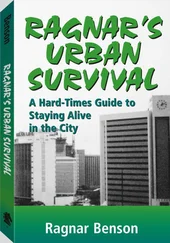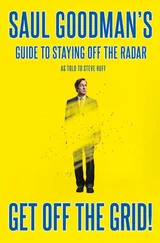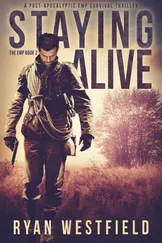Ragnar Benson - Ragnar's Urban Survival - A Hard-Times Guide to Staying Alive in the City
Здесь есть возможность читать онлайн «Ragnar Benson - Ragnar's Urban Survival - A Hard-Times Guide to Staying Alive in the City» весь текст электронной книги совершенно бесплатно (целиком полную версию без сокращений). В некоторых случаях можно слушать аудио, скачать через торрент в формате fb2 и присутствует краткое содержание. Год выпуска: 2009, ISBN: 2009, Жанр: Старинная литература, на английском языке. Описание произведения, (предисловие) а так же отзывы посетителей доступны на портале библиотеки ЛибКат.
- Название:Ragnar's Urban Survival: A Hard-Times Guide to Staying Alive in the City
- Автор:
- Жанр:
- Год:2009
- ISBN:1581600593
- Рейтинг книги:5 / 5. Голосов: 1
-
Избранное:Добавить в избранное
- Отзывы:
-
Ваша оценка:
- 100
- 1
- 2
- 3
- 4
- 5
Ragnar's Urban Survival: A Hard-Times Guide to Staying Alive in the City: краткое содержание, описание и аннотация
Предлагаем к чтению аннотацию, описание, краткое содержание или предисловие (зависит от того, что написал сам автор книги «Ragnar's Urban Survival: A Hard-Times Guide to Staying Alive in the City»). Если вы не нашли необходимую информацию о книге — напишите в комментариях, мы постараемся отыскать её.
Ragnar's Urban Survival: A Hard-Times Guide to Staying Alive in the City — читать онлайн бесплатно полную книгу (весь текст) целиком
Ниже представлен текст книги, разбитый по страницам. Система сохранения места последней прочитанной страницы, позволяет с удобством читать онлайн бесплатно книгу «Ragnar's Urban Survival: A Hard-Times Guide to Staying Alive in the City», без необходимости каждый раз заново искать на чём Вы остановились. Поставьте закладку, и сможете в любой момент перейти на страницу, на которой закончили чтение.
Интервал:
Закладка:
Other disinfecting of bedding, clothes, and linens can be undertaken at the retreat in a kind of homemade, temporary autoclave. This device can be as simple as an old-fashioned covered cooker with a coarse rack in the bottom into which a pint of clean water is placed. When the water is boiled, steam penetrates upward into the clothes, doing a job on growies and little critters. Hopefully, it is obvious that clothes and bedding so treated are first thoroughly washed, using up yet more of our precious water supplies and time.
Place the covered container with cloth to be sterilized inside, over a gentle fire. Heat till the water is long gone, virtually scorching the clothes inside. During our Civil War, women working as nurses who were sufficiently fastidious to hot-iron all their laundry basically accomplished similar effects. Private people could do this work for individual patients, but on an areawide basis after a major battle it was unthinkable. Ironing clothes is easier today but not as widely done in our wash-and-wear society. At any rate, few clothes irons will be working after a collapse.
Good, sound shelters are necessary if our patients are to recover. These must be secure places that can be kept warm and dry, where meals can be provided and where waste disposal doesn't become an issue. Patients kept comfortable, without undue stress, for extended periods obviously are more likely to make it.
In cases of nursing situations, it may be necessary to pull way, way back, away from the conflict to a place of really deep seclusion. Great amounts of convenience, including accessibility to vital supplies, may need to be sacrificed for the sake of the patient and his recovery.
City survivors who take up nursing should also be aware that down through history this has been a very dangerous undertaking. Getting caught by the enemy is easier when mobility is sacrificed, and the penalty for getting caught is often summary execution. During our Civil War, the woman who did nothing more than rent a sleeping room to John Wilkes Booth was actually hanged by our military for her part in the assassination of Abraham Lincoln!
City survivors in general must engage in some pretty deep hiding. Those who also go into nursing will have to become absolutely paranoid. Witness the World War II Nazi treatment of Polish, Ukrainian, and Russian peasants who even thought about sheltering Jews.
ENERGY
Survival nursing will require prodigious quantities of energy for heating and hot water, Jackie, a nurse with long experience and now living in Chicago, told me. I asked what "prodigious" meant. She said it will take lots and lots of energy to heat water and the retreat, sterilize medical tools and bandages, cook food, and accomplish other tasks she couldn't presently think of to run any kind of a successful nursing program. Perhaps more than double what is needed for normal, day-to-day survival activities.
I then asked Betty Lou, who in the past 60 years has nursed scores of people back to health under incredibly primitive circumstances, about energy. "I buy wood from the people and I have 55gallon barrels of kerosene delivered in, and of course any woman nurse should know how to run a chain saw"
"Run a chain saw?" I questioned.
"Yup, and here are the things women need to know," Betty Lou said. They sound practical for men as well. I repeat verbatim.
1. "Always use a Stihl-brand chain saw," she stated. "Others are too heavy, not sufficiently well made, and too hard to start. Women can't yank their shoulders out of joint pulling starter ropes on stupid, slowstarting chain saws, and they can't continually play around with petty maintenance," she continued.
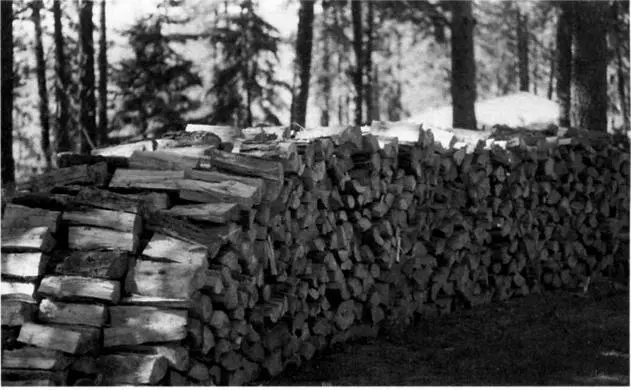
Nurses will use incredible amounts of fuel and may need to crank up their chain saws to make firewood.
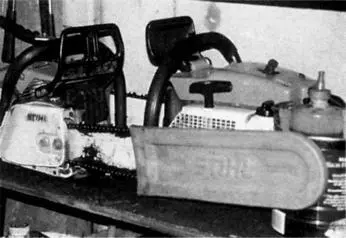
A small, light Stihl model OV 28 is the most practical chain saw for women.
2. Use a smaller, lighter Stihl model OV 28 or thereabouts, weighing at most 7 to 9 pounds. Use at most a 20-inch bar (assembly on which the cutting chain runs). This will still cut through a 4-foot diameter tree, but won't pull smaller built women's arms out of joint during operations.
3. Pay great care to keeping the chain lubricated by refilling the chain lubrication reservoir with special oil at least every 30 minutes of operation. Women tend to forget this step. Chain oil is available from hardware or chain saw stores.
4. Never allow the chain to touch the ground, even when the saw is not running. A single, small nail in scrap lumber or a pebble can easily cause damage, requiring an hour of refiling the chain.
5. Learn to sharpen the chain and keep it very sharp.
This last item seemed like being told, "Win the lottery and live happily ever after." I asked Betty Lou to explain.
"Buy several chain saw files from the dealer of exactly the correct size," she explained. "These will probably be 7/32-inch size. Also, purchase a chain saw filer's guide, which holds the file high enough on the teeth so they are not hooked while providing guide marks so that the correct file angles are maintained.
"Tighten the chain on the bar so that it can be pulled up about half a tooth section on the guide bar and then begin to sharpen.
"File only from inside out, cutting only on the outstroke. Don't ever draw the file back across the tooth. Only push out. File one side completely and then turn the saw around to do all the teeth on the other side the same way"
Betty Lou pitches the file after six or eight uses. "My hands are not as strong as some me's's hands. I don't like to keep using a dull, slow-cutting file," she says. She also cuts up lots of old building material, boards, beams, and wood siding. Often these have some small nails or screws. "Hi: one and its another 60 minutes resharpening the chain," she says. "These smaller, lighter, less powerful saws work poorly when their chains are dull," she says.
'Aren't there easier ways of securing energy?" I asked.
"Yes," she says, "but they are seldom convenient and survival nursing takes so much time and energy that we always have to be ready to use whatever is close at hand."
WATER
Water is another critical element of survival nursing. Great quantities of pure, wholesome water are required to hydrate patients, clean the retreat, and cook. Much of this must be hot water, suggesting yet another use for our already dwindling energy supplies.
Betty Lou developed a spring outside the city in which she usually works, but this technology is probably outside the scope of this book. But by whatever means, water supplies in a survival nursing situation must be dramatically expanded. It also calls for expansion of water-purifying systems.
It is best to plan for a bigger, better sand filtration rack, more bleach, and perhaps ever. some of the more expensive, faster acting water purification chemicals. Upping bleach use to 3 ounces per gallon, and/or allowing the mixture to sit 24 hours rather than 12 is workable. If survival nursing seems a possibility, lay in some 35percent food-grade peroxide (which also stores relatively poorly). Have a supply of tetracycline hydroperiodide and titratable iodine tablets or even some plain old iodine tablets from your local pharmacy Check local pharmacies, mail-order preparedness people, or backpack supply outlets for these chemicals. All are quite expensive, limiting use to nursing candidates.
Using one of the popular little 1-quart-per-minute 2-micron backpack filters is also a possibility. They range in price from $60 to about $150. From 200 to 300 gallons of water can be purified before another $50 filter must be installed. Most retreaters run their water through the sand filter first. Cost, speed, and service life usually limit these devices to producing water for patients.
Читать дальшеИнтервал:
Закладка:
Похожие книги на «Ragnar's Urban Survival: A Hard-Times Guide to Staying Alive in the City»
Представляем Вашему вниманию похожие книги на «Ragnar's Urban Survival: A Hard-Times Guide to Staying Alive in the City» списком для выбора. Мы отобрали схожую по названию и смыслу литературу в надежде предоставить читателям больше вариантов отыскать новые, интересные, ещё непрочитанные произведения.
Обсуждение, отзывы о книге «Ragnar's Urban Survival: A Hard-Times Guide to Staying Alive in the City» и просто собственные мнения читателей. Оставьте ваши комментарии, напишите, что Вы думаете о произведении, его смысле или главных героях. Укажите что конкретно понравилось, а что нет, и почему Вы так считаете.


